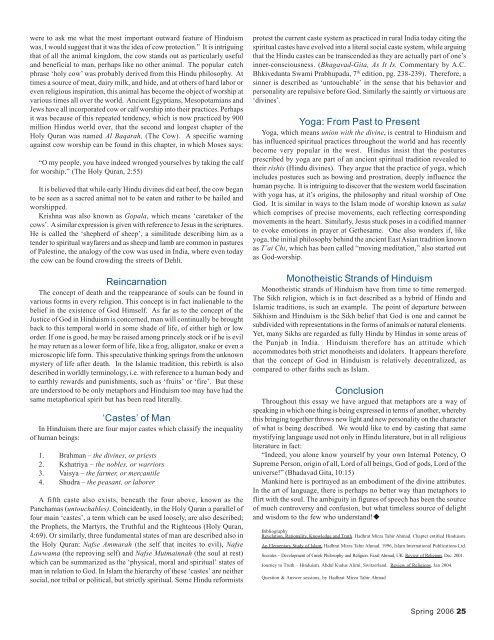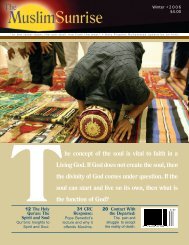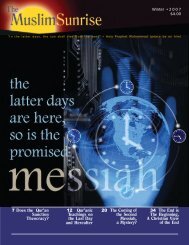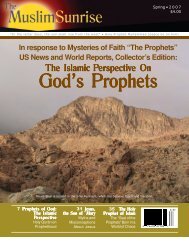Create successful ePaper yourself
Turn your PDF publications into a flip-book with our unique Google optimized e-Paper software.
were to ask me what the most important outward feature of Hinduismwas, I would suggest that it was the idea of cow protection.” It is intriguingthat of all the animal kingdom, the cow stands out as particularly usefuland beneficial to man, perhaps like no other animal. <strong>The</strong> popular catchphrase ‘holy cow’ was probably derived from this Hindu philosophy. Attimes a source of meat, dairy milk, and hide, and at others of hard labor oreven religious inspiration, this animal has become the object of worship atvarious times all over the world. Ancient Egyptians, Mesopotamians andJews have all incorporated cow or calf worship into their practices. Perhapsit was because of this repeated tendency, which is now practiced by 900million Hindus world over, that the second and longest chapter of theHoly Quran was named Al Baqarah, (<strong>The</strong> Cow). A specific warningagainst cow worship can be found in this chapter, in which Moses says:“O my people, you have indeed wronged yourselves by taking the calffor worship.” (<strong>The</strong> Holy Quran, 2:55)It is believed that while early Hindu divines did eat beef, the cow beganto be seen as a sacred animal not to be eaten and rather to be hailed andworshipped.Krishna was also known as Gopala, which means ‘caretaker of thecows’. A similar expression is given with reference to Jesus in the scriptures.He is called the ‘shepherd of sheep’, a similitude describing him as atender to spiritual wayfarers and as sheep and lamb are common in pasturesof Palestine, the analogy of the cow was used in India, where even todaythe cow can be found crowding the streets of Dehli.Reincarnation<strong>The</strong> concept of death and the reappearance of souls can be found invarious forms in every religion. This concept is in fact inalienable to thebelief in the existence of God Himself. As far as to the concept of theJustice of God in Hinduism is concerned, man will continually be broughtback to this temporal world in some shade of life, of either high or loworder. If one is good, he may be raised among princely stock or if he is evilhe may return as a lower form of life, like a frog, alligator, snake or even amicroscopic life form. This speculative thinking springs from the unknownmystery of life after death. In the Islamic tradition, this rebirth is alsodescribed in worldly terminology, i.e. with reference to a human body andto earthly rewards and punishments, such as ‘fruits’ or ‘fire’. But theseare understood to be only metaphors and Hinduism too may have had thesame metaphorical spirit but has been read literally.‘Castes’ of ManIn Hinduism there are four major castes which classify the inequalityof human beings:1. Brahman – the divines, or priests2. Kshatriya – the nobles, or warriors3. Vaisya – the farmer, or mercantile4. Shudra – the peasant, or laborerA fifth caste also exists, beneath the four above, known as thePanchamas (untouchables). Coincidently, in the Holy Quran a parallel offour main ‘castes’, a term which can be used loosely, are also described;the Prophets, the Martyrs, the Truthful and the Righteous (Holy Quran,4:69). Or similarly, three fundamental states of man are described also inthe Holy Quran: Nafse Ammarah (the self that incites to evil), NafseLawwama (the reproving self) and Nafse Mutmainnah (the soul at rest)which can be summarized as the ‘physical, moral and spiritual’ states ofman in relation to God. In Islam the hierarchy of these ‘castes’ are neithersocial, nor tribal or political, but strictly spiritual. Some Hindu reformistsprotest the current caste system as practiced in rural India today citing thespiritual castes have evolved into a literal social caste system, while arguingthat the Hindu castes can be transcended as they are actually part of one’sinner-consciousness. (Bhagavad-Gita, As It Is. Commentary by A.C.Bhkivedanta Swami Prabhupada, 7 th edition, pg. 238-239). <strong>The</strong>refore, asinner is described as ‘untouchable’ in the sense that his behavior andpersonality are repulsive before God. Similarly the saintly or virtuous are‘divines’.Yoga: From Past to PresentYoga, which means union with the divine, is central to Hinduism andhas influenced spiritual practices throughout the world and has recentlybecome very popular in the west. Hindus insist that the posturesprescribed by yoga are part of an ancient spiritual tradition revealed totheir rishis (Hindu divines). <strong>The</strong>y argue that the practice of yoga, whichincludes postures such as bowing and prostration, deeply influence thehuman psyche. It is intriguing to discover that the western world fascinationwith yoga has, at it’s origins, the philosophy and ritual worship of OneGod. It is similar in ways to the Islam mode of worship known as salatwhich comprises of precise movements, each reflecting correspondingmovements in the heart. Similarly, Jesus stuck poses in a codified mannerto evoke emotions in prayer at Gethesame. One also wonders if, likeyoga, the initial philosophy behind the ancient East Asian tradition knownas T’ai Chi, which has been called “moving meditation,” also started outas God-worship.Monotheistic Strands of HinduismMonotheistic strands of Hinduism have from time to time remerged.<strong>The</strong> Sikh religion, which is in fact described as a hybrid of Hindu andIslamic traditions, is such an example. <strong>The</strong> point of departure betweenSikhism and Hinduism is the Sikh belief that God is one and cannot besubdivided with representations in the forms of animals or natural elements.Yet, many Sikhs are regarded as fully Hindu by Hindus in some areas ofthe Punjab in India. Hinduism therefore has an attitude whichaccommodates both strict monotheists and idolaters. It appears thereforethat the concept of God in Hinduism is relatively decentralized, ascompared to other faiths such as Islam.ConclusionThroughout this essay we have argued that metaphors are a way ofspeaking in which one thing is being expressed in terms of another, wherebythis bringing together throws new light and new personality on the characterof what is being described. We would like to end by casting that samemystifying language used not only in Hindu literature, but in all religiousliterature in fact:“Indeed, you alone know yourself by your own Internal Potency, OSupreme Person, origin of all, Lord of all beings, God of gods, Lord of theuniverse!” (Bhadavad Gita, 10:15)Mankind here is portrayed as an embodiment of the divine attributes.In the art of language, there is perhaps no better way than metaphors toflirt with the soul. <strong>The</strong> ambiguity in figures of speech has been the sourceof much controversy and confusion, but what timeless source of delightand wisdom to the few who understand!BibliographyRevelation, Rationality, Knowledge and Truth. Hadhrat Mirza Tahir Ahmad. Chapter entitled Hinduism.An Elementary Study of Islam. Hadhrat Mirza Tahir Ahmad. 1996, Islam International Publications Ltd.Socrates – Development of Greek Philosophy and Religion. Fazal Ahmad, UK. Review of Religions, Dec. 2001.Journey to Truth – Hinduism. Abdul Kudus Alimi, Switzerland. Review of Religions, Jan 2004.Question & Answer sessions, by Hadhrat Mirza Tahir AhmadSpring <strong>2006</strong> 25










